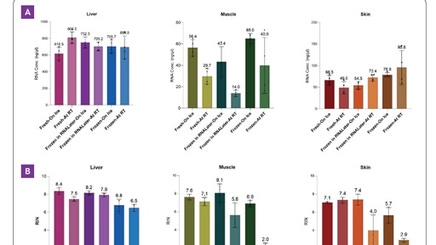
RNA extraction from murine tissues: balancing preservation and extraction parameters for cryogen-free processing

Efficient RNA extraction is important to the success of downstream assays, including transcriptomic analysis. RNA can be fragile and be prone to degradation, so labs consider a range of factors, including sample storage conditions, sample homogenization, and extraction methods that could help obtain robust yields and integrity scores while permitting a practical solution to streamline or standardize protocols for diverse tissue samples.
In this application note, review performance data from mouse liver, skeletal muscle, and skin:
- Comparative data across three sample acquisition/storage parameters: fresh, frozen, and frozen in RNAlater™
- Resulting RNA yield, RIN data, and statistical analysis from tissue extraction on ice or at room temperature
- Optimized homogenization parameters for each tissue type using bead mill homogenization
Table 3: Overview of RNA yield, integrity (RIN), and purity (A260/A280, A260/A230) across different extraction conditions from 10 mg samples, arranged by ascending RIN values for Liver (a, purple), Muscle (b, green) and Skin (c, orange) samples.
| Sample Storage | Extraction Conditions | Average RNA Conc. (ng/μl) | Average RIN | Standard Deviation of RIN | Average 260/280 | |
|---|---|---|---|---|---|---|
| Muscle | Frozen in RNA later | On Ice | 43.4 | 8.1 | 0.8 | 2.1 |
| Fresh | On Ice | 56.4 | 7.7 | 0.2 | 2.2 | |
| Frozen | On Ice | 65.0 | 6.9 | 0.3 | 2.1 | |
| Fresh | At Room Temp. | 29.7 | 6.9 | 0.1 | 2.3 | |
| Frozen in RNA later | At Room Temp. | 14.0 | 5.6 | 1.4 | 2.5 | |
| Frozen | At Room Temp. | 40.0 | 2.0 | 0.6 | 2.1 | |
| Skin | Frozen in RNA later | On Ice | 54.5 | 7.4 | 0.5 | 2.1 |
| Fresh | At Room Temp. | 49.0 | 7.4 | 0.3 | 2.0 |
To view the full table, please fill out the form below.
For research use only. Not for use in diagnostic procedures.
To view the full content please answer a few questions
Download Resource
RNA extraction from murine tissues: balancing preservation and extraction parameters for cryogen-free processing




























